Subphylum Vertebrata Suborder Iguania or Sauria Scientific name Basiliscus basiliscus Higher classification Basiliscus | Rank Species | |
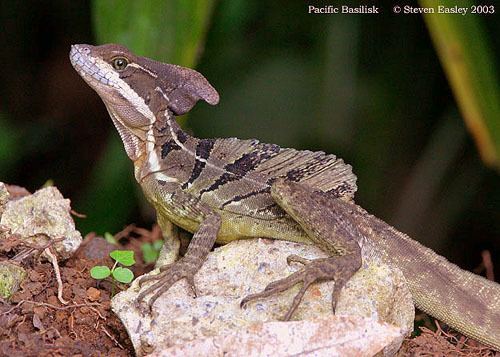 | ||
Similar Basiliscus, Plumed basilisk, Reptile, Brown basilisk, Scaled reptiles | ||
The common basilisk (Basiliscus basiliscus) is a lizard found in Central and South American rainforests near rivers and streams. The basilisk is part of the corytophanid family. It is also known as the Jesus lizard, Jesus Christ lizard, or lagarto de Jesus Cristo for its ability to run on the surface of water.
Contents
- Description
- Range and habitat
- Diet
- Predators
- Reproduction
- Locomotion on water
- Taxonomy and etymology
- References
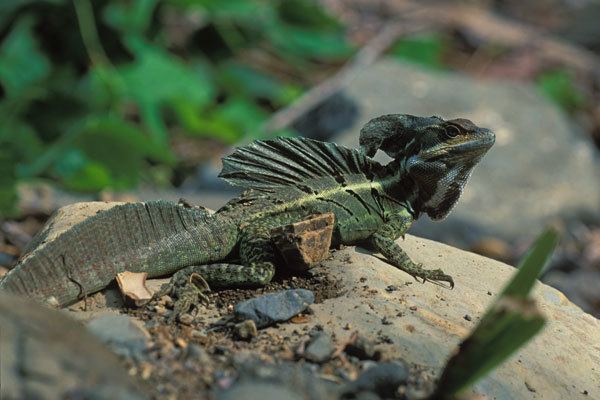
Description
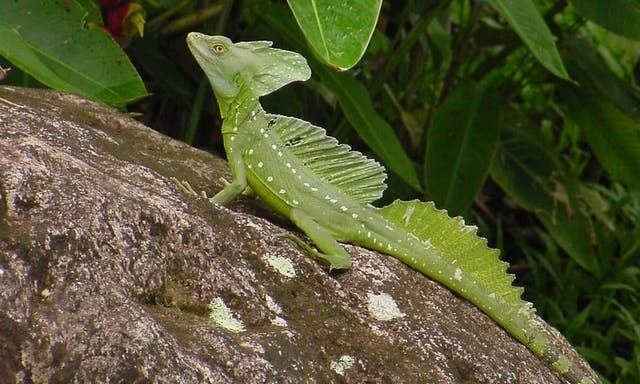
The common basilisk can be distinguished from similar species within its range by its large size and the high fin-like crests down its back. Most are brown and cream in colour. Males also have high crests on their heads and tails. Both sexes are brown to olive, and have a white, cream or yellow stripe on the upper lip and a second stripe along either side of their bodies; these stripes have higher contrast in juveniles and fade as the lizards age. Hatchlings weigh a mere 2 g and are 37 to 43 mm long. Adults can grow up to two and a half feet long. Females are generally 135 to 194 g, and weigh half as much as males. The tails of these lizards comprise 70 to 75% of their total length: for example, on an 800-mm-long (31.5-in-long) lizard, 600 mm of its length is tail.
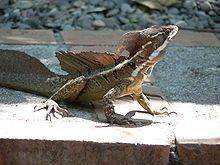
The common basilisk has a large mouth with saw-like teeth on the inner sides of the jaw. They have been known to run up to 7 mph (11 km/h). While the basilisk is most known for its ability to run on water, it is also an excellent climber and swimmer; the basilisk has been known to stay under water for up to half an hour. The average lifespan is seven years in captivity; in the wild, it tends to be less because of predators.
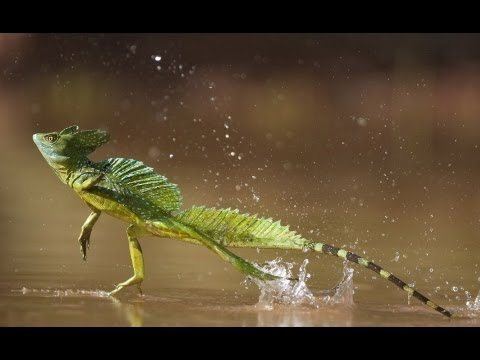
When startled, the common basilisk escapes by speeding to the nearest edge of water—and continues sprinting. The lizard runs on only its hind legs in an erect position, holding its fore legs to its sides. This basilisk is so adroit on water because its feet are large and equipped with flaps of skin along the toes that allow it to catch on tiny air bubbles. When moving quickly, the lizard can cross a surface of water before sinking. On water, it runs an average speed of 8.4 km/h (or 5.2 mph), which is just a little slower than its speed on land. Younger basilisks can run 10 to 20 meters on water, while adults cross only a few meters before sinking. Adults do not move slowly, but they weigh more and cannot sprint for as long a time. Once a basilisk submerges, it continues swimming until it is sufficiently far from its pursuer—if the predator has followed past the bank. Although this lizard stays close to water to escape terrestrial predators, it swims only when necessary because some other aquatic animals would eat the basilisk given the chance.
Range and habitat

The common basilisk is found in tropical rainforests throughout Central America and in northwestern South America, usually living in low elevations, from sea level to 600 m. In Costa Rica, this basilisk can be found as high as 1,200 m in some places. The species ranges from southwestern Nicaragua to northwestern Colombia on the Pacific side, and from central Panama to northwestern Venezuela on the Atlantic side. In Costa Rica, it is mostly found on the Pacific side of the country. The equivalent species on the Atlantic side is the green basilisk, which occupies similar habitats and has similar biology. It has been introduced to Florida as a feral species.
Diet

This basilisk is an omnivore; its diet consists of insects, flowers, and small vertebrates such as snakes, birds, eggs, and fish.
Predators

The common basilisk has many natural predators - large reptiles, birds, and some mammals. To avoid predators, it can conceal itself under leaves on the forest floor and can remain motionless for a long time. When the common basilisk must flee, though, its skill of running on water can help it avoid many predators.
Reproduction
Females lay three to four clutches of 10–20 eggs a year. Eggs hatch after about three months and the young weigh about two grams and are up to three inches long. Their outstanding camouflage allows them to remain undetected when they remain still.
Locomotion on water
The common basilisk, along with the other members of its genus, take the nickname the "Jesus Christ lizard" or "Jesus lizard" because when fleeing from predators, they gather sufficient momentum to run across the water for a brief distance while holding most of their body out of the water (similar to the Biblical miracle of Jesus walking on water). Basilisks have large hind feet with scaly fringes on the sides of the third, fourth, and fifth toes. These are compressed against the toes when this lizard walks on land; but if it senses danger, it can jump into the water, opening up these fringes against the water's surface. This increases the surface area of the foot, thus allowing it to run on the water for short distances. This occurs in three steps. First is the slap, the downward movement of the foot that pushes water out and away from the leg. This also created pockets of air around the foot. Next is the stroke, the backwards movement of the foot, which propels it forward. Next is the recovery, when the foot comes up and out of the water and prepares to do the slap again. Smaller basilisks can run about 10–20 m without sinking. Juveniles can usually run farther than older basilisks, while holding more of their body above the surface.
Taxonomy and etymology
The common basilisk is named for the creature of Greek mythology made up of parts of a rooster, snake, and lion which could turn a man to stone by its gaze: the basilisk. Its generic, specific and common names all derive from the Greek basilískos (βασιλίσκος) meaning "little king". The specific epithet was given in Carl Linnaeus' 10th edition of Systema Naturae.
